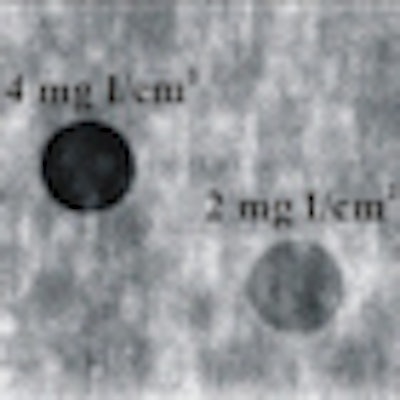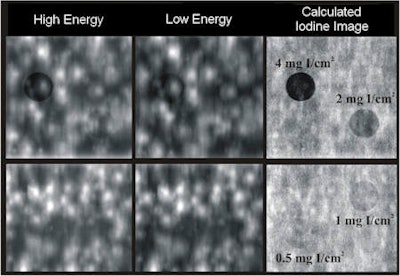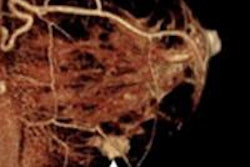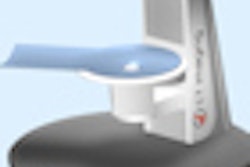
The improved diagnostic certainty due to CT's high sensitivity and specificity for earlier recognition and diagnosis of breast cancer lesions may have a substantial future impact on patient management, and improve outcomes.
Limited spatial resolution and specificity are acknowledged as the main drawbacks of full-field digital mammography (FFDM) when it comes to early detection of microcalcifications, an indicator of potential breast cancer. While MRI may seem a more obvious choice to improve FFDM's performance, the possibility of 3D imaging with CT at very high resolution and low radiation dose of 1 mSv to 5 mSv could provide an alternative method for early breast cancer detection and characterization in the clinical setting.
The use of advanced CT technology may mean a breakthrough for breast imaging, according to Willi Kalender, PhD, chairman of the Institute of Medical Physics at the University of Erlangen, Germany. He is a speaker at the opening session of the European Federation of Organisations for Medical Physics (EFOMP) Workshop about advances in breast imaging.
"We are working on cadmium telluride detector technology, which allows direct conversion of x-rays into an electrical signal without the intermediate step of scintillation light. With respect to clinical imaging, the planned dedicated breast CT scanner will be its first application for high-resolution imaging at low dose," Kalender said. "CT imaging of the breast with 3D detail will obviate obscuring features, as it did for chest radiography, and will allow us to approach 100% sensitivity, compared to the current 60% to 70% sensitivity in mammography screening."
CT is unlikely to replace mammography screening, but the expectation of improved diagnostic power means it may be increasingly used as a second-line examination in the clinical setting. Additional research is needed to confirm the expected performance of high-resolution CT of about 100 micrometers (µm) and patient dose comparable to that applied in biplane screening mammography. If the findings are positive, CT might also qualify for screening purposes.
Kalender began efforts to build a dedicated breast CT scanner in 2007, and preliminary proof of imaging performance was obtained in practical tests. A pilot study to prove clinical feasibility will begin this year through a partnership with several European centers and Artemis Imaging, a spin-off of the University of Erlangen in Germany. More extensive testing is due to start in 2012 and will involve five European and five U.S. institutions.
Doubts remain about CT's cost-effectiveness and patient exposure to radiation, but the benefits of dedicated breast CT are manifold -- it may help to complement mammography in some cases. He thinks it will be possible to visualize soft-tissue lesions smaller than 5 mm in diameter and microcalcifications at 100 µm or better, adding that painful compression of the breast during studies will be avoided and radiation exposure will be limited to a dose not exceeding that acceptable in standard mammography. He also pointed to the possibility of an integrated biopsy facility that would mean a "one-stop shop" option, compared with the current situation in which biopsies are scheduled separately after the screening examination if there is suspicion.
"The MR biopsy procedure is relatively difficult and time-consuming, and the delay is a psychological burden for patients," said Kalender. "Dynamic CT will be able to show morphology, microcalcifications, and contrast enhancement, with scans entailing integrated biopsy."
Delegates at the opening session also heard about the latest developments in color x-ray obtained using different technologies, a growing area of interest in breast imaging. Besides its application in conventional chest imaging, color x-ray using dual-energy techniques is gaining ground for other potential clinical applications because it allows increased visibility and improved characterization of tumors, according to co-speaker Christer Ullberg, chief technical officer at Stockholm-based Xcounter, which develops digital detectors. For breast imaging, contrast media is needed for substantially improved visualization gained from separating energies. This means that although the technique looks set to play a diagnostic role for individual patients, it is not likely to be used in screening programs, at least in the foreseeable future.
 This is a dual-energy image of an iodine phantom. The left image was taken with high energy. The middle image was taken with low energy. The right-hand image is the resulting image that shows the iodine disks much more clearly than the other two. The background structure is also greatly reduced. Image courtesy of Christer Ullberg.
This is a dual-energy image of an iodine phantom. The left image was taken with high energy. The middle image was taken with low energy. The right-hand image is the resulting image that shows the iodine disks much more clearly than the other two. The background structure is also greatly reduced. Image courtesy of Christer Ullberg."The radiologist needs to be aware that color x-ray in breast imaging can help to an extent, but contrast media is needed to highlight tumors in a dense breast. Without it, you don't gain much by using dual energy in color x-ray," Ullberg said.
Ullberg highlighted the different methods available for color x-ray imaging and their strengths and drawbacks, as well as the effect of scattered radiation, which presents a further challenge for radiologists and system designers. When designing a system, scatter correction needs to be taken into consideration to obtain quality images, and this is especially important for color x-ray imaging because scatter can change the color of the x-ray. For implementation of dual energy in mammography, systems must also undergo some technical improvements. Efforts, for example, are being made to reduce the two exposures currently needed in dual-energy techniques to a single exposure. In addition, to convince the authorities and radiologists about its clinical application, researchers must prove that dual energy is of real benefit.
EFOMP represents more than 5,000 physicists and engineers in the field of medical physics. Its ECR workshop is always a popular attraction at the congress.
Originally published in ECR Today March 5, 2011.
Copyright © 2011 European Society of Radiology



















